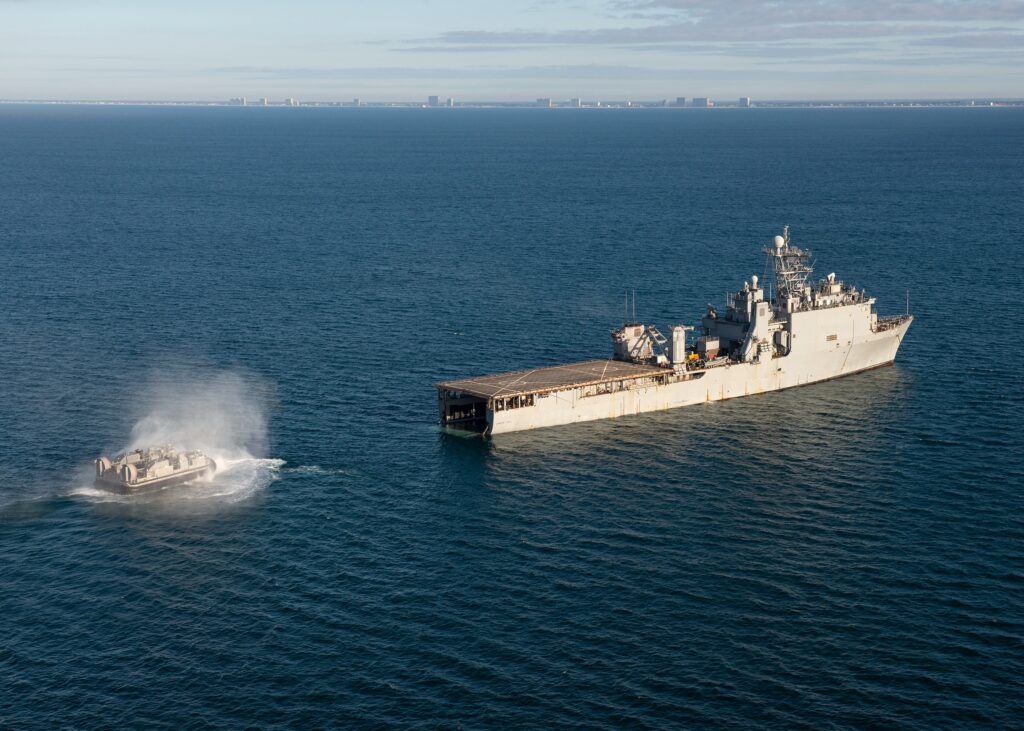
*******
ARLINGTON, Va. — Three U.S. Navy ships, a Military Sealift Command ship, and three Coast Guard cutters have sortied from the U.S. East Coast and are participating in the search and recovery effort for the payload of the Chinese balloon that was shot down over U.S. territorial waters off South Carolina.
The Harpers Ferry-class dock landing ship USS Carter Hall (LSD 50), Ticonderoga-class guided-missile cruiser USS Philippine Sea (CG 58) and Arleigh Burke-class guided-missile destroyer USS Oscar Austin (DDG 79) took up station to track the descent of the balloon’s payload as it fell into the water.
The ships now include the USNS Pathfinder (T-AGS 60), an oceanographic survey ship operated by the Military Sealift Command.
The Coast Guard also has deployed to the salvage area three cutters — USCGC Venturous (WMEC 625), USCGC Richard Snyder (WPC 1127), and USCGC Nathan Bruckenthal (WPC 1128) — as well as small boats and aircraft to ensure the safety of the salvage area.
According to the Defense Department, the payload fell into a depth of 47 feet of water, a depth easily accessible to divers.
Gen. Glen VanHerck, Commander, North American Aerospace Defense Command and United States Northern Command, briefing reporters Feb. 6, said that the recovery effort was being led by Adm. Daryl Caudle, commander of U.S. Fleet Forces Command and U.S. Naval Forces, U.S. Northern Command.
VanHerck said the Navy ships in the vicinity of the splashdown of the balloon are collecting and categorizing debris.
“The Pathfinder is a ship that conducts survey operations using sonar and other means to map out the debris field,” VanHerck said. “It’s capable of conducting oceanographic, hydrographic, bathymetric surveys of the bottom of the ocean to do that. And they’ll eventually produce us a map — they’re in the process of doing that, and I expect to have much more today — of the full debris field. But we expect the debris field to be of the rough order of magnitude of about 1,500 meters by 1,500 meters, and so, you know, more than 15 football fields by 15 football fields. But we’ll get a further assessment of that today.”
VanHerck said that “[y]esterday’s sea states did not allow us to conduct some of the operations that we would have liked to have conducted such as underwater surveillance. And so those forces that provide the explosive ordnance disposal to make sure the scene is safe, they’re out today, this morning, and they went out in what’s called a rigid hull inflatable boat this morning, Eastern time approximately 10:00 o’clock, to proceed to the — the area to utilize unmanned underwater vehicles using side scan sonar to further locate sunken debris. And so, we expect them to get on there and to do some additional categorization of potential threats such as explosives that may be on, hazardous materials that could be in batteries, et cetera, so we’re working very hard.
The Military Sealift Command operates two dedicated salvage ships, but both are based in the Pacific Ocean.
The balloon, floating at about 60,000 feet above sea level, was launched by China on Jan. 21 and crossed into U.S. airspace over the Aleutian Islands on Jan. 28. It crosses over Canada and into the continental United States over Idaho on Jan. 31. President Joe Biden gave the order to shoot down the balloon on Feb. 1.
“Military commanders determined that there was undue risk of debris causing harm to civilians while the balloon was over land,” a senior Defense Department official said in a Feb. 5 briefing to reporters. ”As a result, they developed a plan to down the balloon once it was over water in U.S. territorial airspace. That mission has now been successfully completed. At the direction of the president, the U.S. military, at 2:39 p.m. this afternoon, shot down the high-altitude surveillance balloon off the coast of South Carolina and within U.S. territorial airspace.”
According to Pentagon spokesman Brig. Gen Patrick Ryder, the Chinese balloon was steerable, and therefore able to be guided over sensitive U.S. defense bases.
On Feb. 4, the balloon was intercepted by two F-22A Raptor fighters launched from Joint Base Eustis-Langley, Virginia. One of the F-22As fired an AIM-9X air-to-air heat-seeking missile that deflated the balloon and sent the balloon’s solar panels and payload crashing into the ocean off Myrtle Beach.
“We have multiple U.S. Navy vessels and Coast Guard vessels in the region right now, establishing a security perimeter, conducting search for any debris that may be on the water to ensure the safety of U.S. civilians, any maritime activity that is ongoing out in the water,” a senior military official said in the Feb. 5 briefing. “We will provide, under NORTHCOM [U.S Northern Command] command and control, a salvage vessel, United States Navy, which will be on-scene within a couple of days. The debris is in 47 feet of water, primarily. The recovery, that will make it fairly easy, actually. We planned for much deeper water.”
The downing of the balloon is the first aerial kill attributed to the F-22A. The two F-22As in the intercept used the callsigns Frank One and Luke One in apparent reference to Frank Luke Jr., the U.S. Army Air Service ace who was credited with downing 14 German observation balloons as well as four airplanes during combat over the Western Front during World War I. Luke died on Sept. 28, 1918, from German machine fire from the ground.






